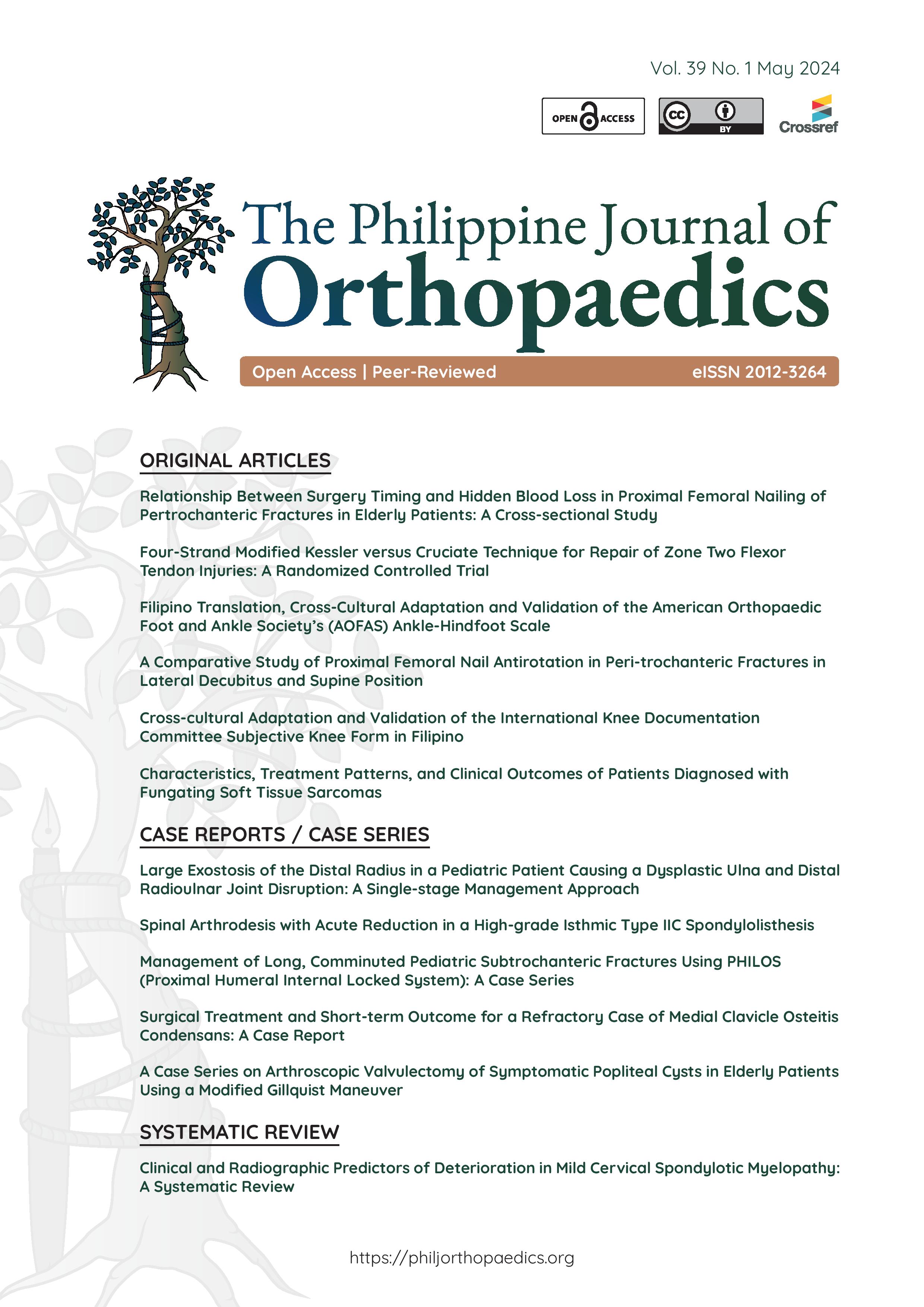A Comparative Study of Proximal Femoral Nail Antirotation in Peri-Trochanteric Fractures in Lateral Decubitus and Supine Position
Main Article Content
Abstract
Objectives. One of the most widely used cephalomedullary devices for unstable peri-trochanteric fractures is the Proximal Femoral Nail Antirotation (PFNA). Adequate reduction and fixation are crucial to achieving ideal function and fracture union. Many factors can contribute to the ease of reduction; one of these is the positioning technique. Numerous reports have addressed the advantages and disadvantages of the positioning techniques for antegrade femoral nailing. This study aimed to compare the quality of fixation, adequacy of reduction, bony union, and functional outcomes in PFNAs done in the lateral decubitus and supine position.
Methodology. This study was a retrospective cohort study conducted at the Philippine Orthopedic Center. Adult male and female (21 to 65 y/o) patients who underwent open reduction with a PFNA either in the supine or lateral position were included in this study. Thirty-nine (39) patients were identified, where six were lost to follow-up, and four did not have retrievable postoperative radiographs. A total of 29 patients were included. The data were analyzed using the T-test in two population means and Fisher’s Exact Test.
Results. At a 95% level of confidence, the study showed no significant differences in the distribution of Tip-Apex Distance (TAD), adequacy of reduction, and bony union at six months post-operatively between the lateral and supine position. In contrast, there was a significant difference in the distribution of the Cleveland index score. Regarding the Harris Hip Score (HHS), there was also a significant difference in the average score between the two groups, but all had an excellent functional outcome.
Conclusion. The preferred surgical position for performing an open reduction and fixation with a PFNA remains controversial. This study showed that the surgical position did not affect the TAD, adequacy of the reduction, and bony union. All patients from both groups had excellent functional outcomes at six months post-operatively, but the lateral position group had superior Cleveland index scores. Surgery with the PFNA in the lateral decubitus position can be performed in small rural hospitals that lack a fracture table. With proper surgical technique, this may be safe, executable, and may benefit more patients with peri-trochanteric fractures.
Article Details

This work is licensed under a Creative Commons Attribution 4.0 International License.

This work is licensed under a Creative Commons Attribution 4.0 International License.
References
Joglekar SB, Lindvall EM, Martirosian A. Contemporary management of subtrochanteric fractures. Orthop Clin North Am. 2015;46(1):21–35. https://pubmed.ncbi.nlm.nih.gov/25435032. https://doi.org/10.1016/j.ocl.2014.09.001.
Forward DP, Doro CJ, O’Toole RV, et al. A biomechanical comparison of a locking plate, a nail, and a 95° angled blade plate for fixation of subtrochanteric femoral fractures. J Orthop Trauma. 2012;26(6):334–40. https://pubmed.ncbi.nlm.nih.gov/22241399. https://doi.org/10.1097/BOT.0b013e3182254ea3.
Court-Brown CM, Heckman JD, McQueen MM, Ricci W, Torneta P III, eds. Rockwood and Green's fractures in adults. 8th ed. Philadelphia: Wolters Kluwer Health; 2015.
Saudan M, Lübbeke A, Sadowski C, Riand N, Stern R, Hoffmeyer P. Pertrochanteric fractures: is there an advantage to an intramedullary nail?: a randomized, prospective study of 206 patients comparing the dynamic hip screw and proximal femoral nail. J Orthop Trauma. 2002;16(6):386-93. https://pubmed.ncbi.nlm.nih.gov/12142826. https://doi.org/10.1097/00005131-200207000-00004.
Schipper IB, Steyerberg EW, Castelein RM, et al. Treatment of unstable trochanteric fractures. Randomised comparison of the gamma nail and the proximal femoral nail. J Bone Joint Surg Br. 2004;86:86–94. https://pubmed.ncbi.nlm.nih.gov/14765872.
Nikoloski A, Osbrough A, Yates P. Should the tip-apex distance (TAD) rule be modified for the proximal femoral nail antirotation (PFNA)? A retrospective study. J Orthop Surg Res. 2013;8:35. https://pubmed.ncbi.nlm.nih.gov/24135331. https://www.ncbi.nlm.nih.gov/pmc/articles/PMC3853127.
https://doi.org/10.1186/1749-799X-8-35.
Kooistra BW, Dijkman BG, Busse JW, Sprague S, Schemitsch EH, Bhandari M. The radiographic union scale in tibial fractures: reliability and validity. J Orthop Trauma. 2010;24 (Suppl 1):S81-6. https://pubmed.ncbi.nlm.nih.gov/20182243. https://doi.org/10.1097/BOT.0b013e3181ca3fd1.
Sonmez MM, Camur S, Erturer E, Ugurlar M, Kara A, Ozturk I. Strategies for proximal femoral nailing of unstable intertrochanteric fractures: lateral decubitus position or traction table. J Am Acad Orthop Surg. 2017;25(3):e37-44. https://pubmed.ncbi.nlm.nih.gov/28134676. https://doi.org/10.5435/JAAOS-D-15-00691.
Ozkan K, Cift H, Akan K, Sahin A, Eceviz E, Ugutmen E. Proximal femoral nailing without a fracture table. Eur J Orthop Surg Traumatol. 2009;20(3):229-31. https://doi.org/10.1007/s00590-009-0550-7.
Ganjale SB. Long PFN nailing in comminuted high subtrochanteric fractures femur in lateral position on ordinary table. Indian J Orthop Surg. 2018;4(3):273-81. https://doi.org/10.18231/2395-1362.2018.0054.
van Belle G, Martin DC. Sample size as a function of coefficient of variation and ratio of means. Am Stat. 1993;47(3):165-7. https://doi.org/10.1080/00031305.1993.10475968.
Cleveland M, Bosworth DM, Thompson FR, Wilson HJ Jr, Ishizuka T. A ten-year analysis of intertrochanteric fractures of the femur. J Bone Joint Surg Am. 1959;41-A:1399-408. https://pubmed.ncbi.nlm.nih.gov/13849408.
Connelly CL, Archdeacon MT. The lateral decubitus approach for complex proximal femur fractures: anatomic reduction and locking plate neutralization: a technical trick. J Orthop Trauma. 2012;26(4):252-7. https://pubmed.ncbi.nlm.nih.gov/22048187. https://doi.org/10.1097/BOT.0b013e31821e0b2d.





